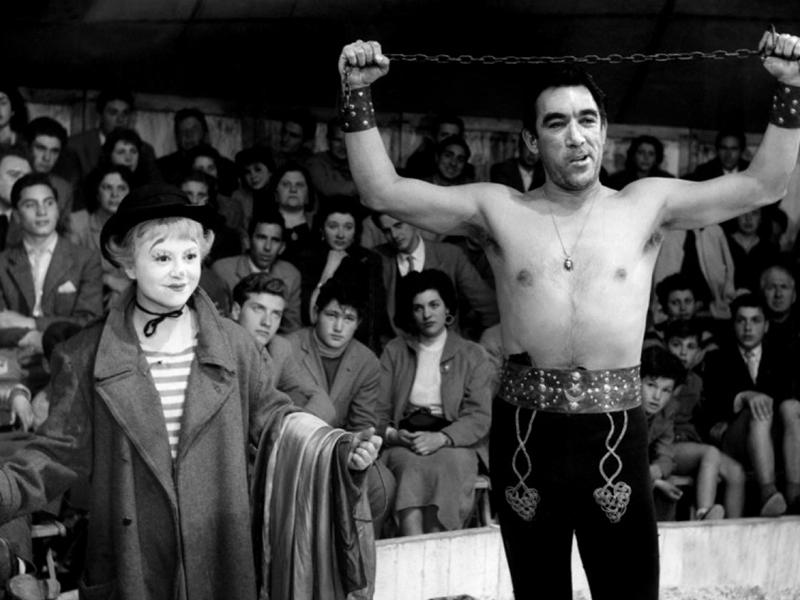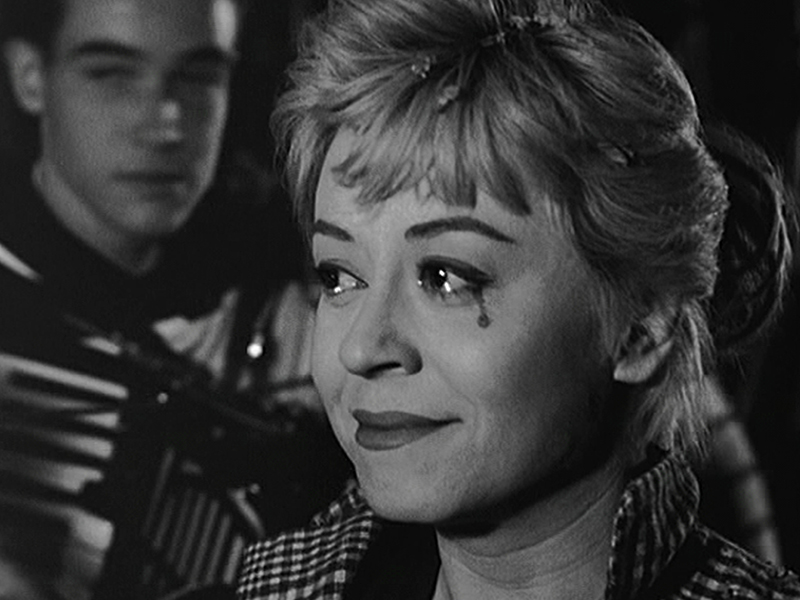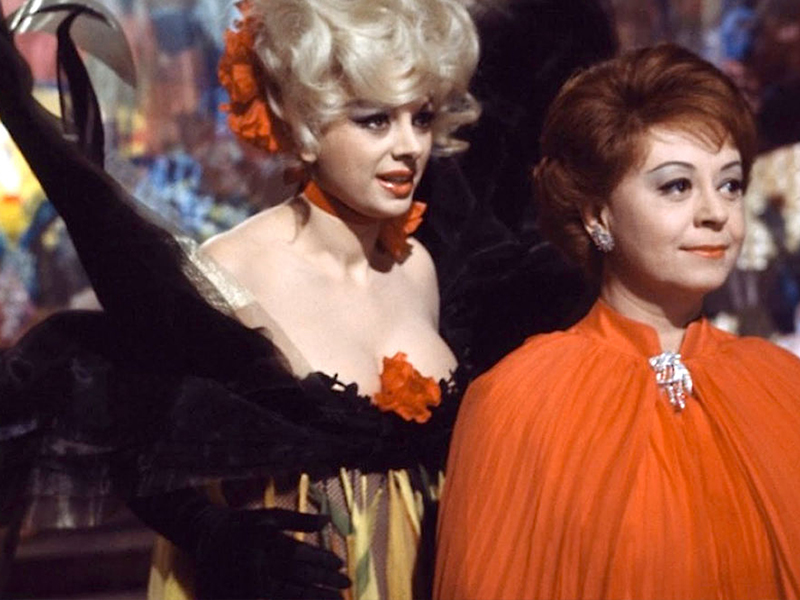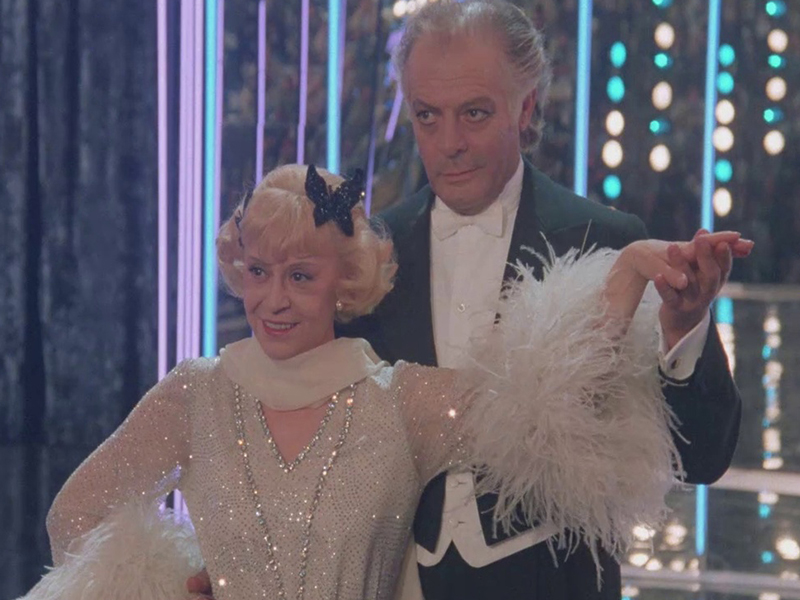Giulietta Masina x4 – Neorealism, autofiction and fantasy
Despite the fact that Giulietta Masina is without a doubt one of the most notorious actresses in Italian cinema, her name is associated almost exclusively with the auteurism of her husband, Federico Fellini. There are too few documents to discuss in more depth who Masina really was – apart from the “muse”, the “inspiration” and so on. Looking back, however, I think the films in which Masina interpreted some remarkable parts (there are seven of them, if we don’t take into account a cameo in Paisa, by Roberto Rossellini) show a type of Chaplin-inspired performance that is less studied/played and more improvised; deriving from silent cinema, Masina relied more on facial expression and less on words – a transparent innocence, which holds on any hint of illusion in a generally rotten world; almost all of her roles coagulate around the “single woman” tragic leitmotif – no matter how much she grows up, she remains a big-eyed child who happily inhales the world around her. Fellini’s cinema derives from the persona built by Masina – all of his heroes live with one foot on the ground and the other one floating around in a dreamland.
Since Fellini will be celebrated this year at Transilvania IFF and some of his films will be shown in a retrospective program, I was inspired to talk about four of the films made by the Italian filmmaker. Although the TIFF selection is more anchored in the bombastic phase of his filmography (where fantasy gradually removes neorealism and the female protagonists), one of the films I will be talking about can be watched at the festival. The other three could easily serve as a warm-up for the festival.
La Strada (1954)

In its apparent simplicity, La Strada is this story dipped in neorealism of Gelsomina, a naive and dreamy girl, who finds it rather hard to adapt to the world around her. Coming from a poor family, she has to leave with Zampano (Anthony Quinn), an amateur street performer, and quite the macho, who buys her from her mother. She joins him in his performing routine, where he ties a chain around his chest and then breaks it apart in an act of showing his extraordinary physical strength. For Zampano, Gelso is his wife, but rather sees her as an object: he hits her with his whip when she doesn’t do the right thing, he doesn’t let her cook because she doesn’t know how, and so on.
For Gelsomina, Zampano is mainly an executioner, and then an improvised knight; after several attempts to escape, she becomes accustomed to being a submissive nomad and comes to see his rusty carriage as a kind of welcoming sanctuary. Her optimism and joy are out of this world – whenever she meets a good person, Gelsomina’s face lights up, but otherwise, when she’s overwhelmed by sadness, she sits in a corner crying and staring into nothing. The striking contrast between Zampano’s volcanic and brutal nature and the purity of Gelsomina finds another companion – Il Motto, a jester who, unlike the two, is independent and creative. In this trio, critic Pauline Kael saw a spiritual fable, with three symbolic characters: Zampano is the body, Gelsomina is the soul, and the jester is the mind. In the end, when he finds himself alone in the world, it’s not the physical chains that break Zampano down, but the news that Gelsomina is no longer alive.
Le Notti di Cabiria/Nights of Cabiria (1957)

In Le Notti di Cabiria, Giulietta Masina plays the part of a prostitute who hides her naivety and innocence from people. She is seen as an outcast – compared to the other women around, she’s a weirdo without any hint of femininity, a real spitfire, with penciled eyebrows, ragged clothes, who goes out every night, working on the streets to keep her small adobe house. Whenever she drinks, Cabiria begins to dance in the middle of the street, as if in a trance; but her euphoria is interrupted by the police raids or the street vagrants’ cussing.
Without building just a simple misery-porn type of character, Masina enriches Cabiria’s life with very colorful encounters – from an unexpected night with a famous actor to a pilgrimage through the suburbs of Rome, where a philanthropist visits poor families living underground, awaiting to get some food. Even if the female character is shown some empathy, one could blame the film for not giving her a real chance at a better life – she is constantly taken advantage of, laughed at, she’s a vagrant clown. No wonder that in the final sequence of the film, where Cabiria, completely ruined, crosses a street full of children, she walks in the opposite direction of them and a tear appears in the corner of her eye.
Giulietta Degli Spiriti/Juliet of the Spirits (1965)

Giulietta Degli Spiriti is Fellini’s first color film, a pretext for a number of extravagances in the set design department (by the way, another film that uses color to illustrate the inner life of the protagonist is Les Parapluies de Cherbourg, released a year before). Here, Giulietta (played by Masina) is more or less an autofictional character – at the time, there was less talk about the visual craziness of the film and more speculation about the fact that Giulietta Degli Spiriti would be about the marital problems inside the Fellini-Masina couple. Fellini himself stated in several interviews that he would dedicate the film to his wife, that it would be “a declaration of love for Giulietta Masina”, etc. However, such an idea would raise some problems: Giulietta Degli Spiriti is about an aristocratic wife who fails to reconcile with her husband’s adultery, she goes to all kinds of psychics, who advise her to make more effort in satisfying her husband, she is invited by an eccentric neighbor to spend a night with a young man, she is advised to become more sexually uninhibited and so on. On top of all this, the protagonist seems to have a constant struggle with some hidden voices (it looks like she’s followed by some female and male spirits).
Masina makes a memorable role here, but unequivocally it feels like she’s been placed in a grotesque Fellini universe in which she doesn’t belong, and the film seems an excuse for Fellini’s fetishistic explorations. In fact, everything that holds true in Giulietta Degli Spiriti comes down to aesthetics: a dream-reality gloomy sensation, a floating vessel in which the spirits of the living and the dead live together. At a psychological / human level, however, things are too mixed up to make any sense whatsoever.
Ginger & Fred (1986)

Ginger & Fred is one of Fellini’s modest titles (and one of his latest films) – however, it’s the only chance for fans to see Masina and Mastroianni playing together again in their old age. Ginger and Fred are an elderly couple of step dancers who in the 40’s were making waves with their impression of Ginger Rogers and Fred Astaire. Invited now by a local television to recreate one of their famous dances, in an anniversary edition for Christmas, the two not only no longer find their place in the media world, but seem to have never left the house in 40 years. Paradoxically, here, Ginger is the more rational part of the couple (leaving aside the innocent / dreamy persona that made Masina famous), while Fred is all sugary and slightly lecherous, an old man with dirty jokes.
The comic effect of the duo is based on their provincialism – an aristocratic world that was out of phase in the ’80s, where their fancy costumes next to the rock stars’ outfits looked quite strange. The film is an opportunity to revisit the typical Fellini characters, from circus people to dwarves – but at the same time attests to the inadequacy of Fellini in the present times – in that way, even he announced that he’s overwhelmed by how much the concept of performance has changed in Italy.
Journalist and film critic, with a master's degree in film critics. Collaborates with Scena9, Acoperișul de Sticlă, FILM and FILM Menu magazines. For Films in Frame, she brings the monthly top of films and writes the monthly editorial Panorama, published on a Thursday. In her spare time, she retires in the woods where she pictures other possible lives and flying foxes.
